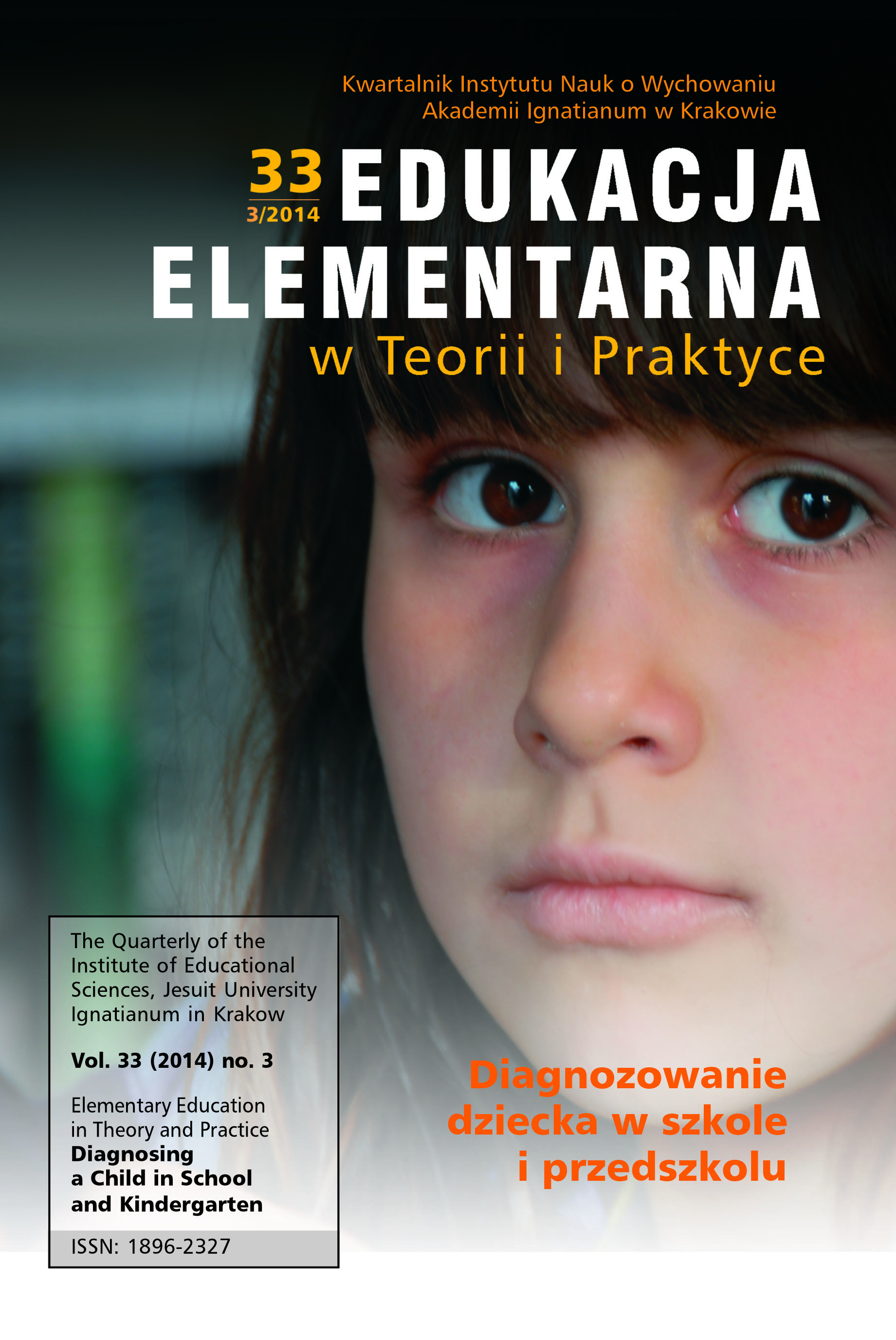Metody i techniki diagnozowania uczniów zdolnych na tle tworzonego przez nauczycieli środowiska sprzyjającego diagnozie
Abstrakt
Dobór metod diagnozy ucznia zdolnego stanowi istotny warunek sukcesu szkolnego tej grupy uczniów. Rolą nauczycieli, pedagogów i psychologów jest znać wiele metod diagnozy ucznia zdolnego i stosować je właściwie, dobierając do każdego ucznia indywidualnie. Powinni oni przy tym uwzględnić jednostkowe potrzeby ucznia zdolnego, rodzaj jego zainteresowań, wiek ucznia i inne ważne czynniki. Nie powinni też zapominać o własnych preferencjach danej metody i techniki diagnostycznej, poziomu jej znajomości i zręczności w użyciu. Współcześni nauczyciele, w szczególności pedagodzy twórczości, posiadają na ogół dość szeroki wybór metod diagnozy uczniów zdolnych. Należą do nich zarówno te ilościowe, jak i jakościowe. Jedne mogą być uzupełniane i wspomagane drugimi. Jakościowe są pomocne w długotrwałej diagnozie, między innymi uwarunkowań społecznych, natomiast ilościowe, na przykład w mierzeniu ilorazu inteligencji. Jednakże niektórzy pedagodzy preferują metody jakościowe, jako bardziej dostosowane do indywidualnych potrzeb ucznia zdolnego i trafniej określające jego predyspozycje. Metody diagnozy uczniów zdolnych powinny być dobierane z dużą świadomością, aby okazały się pomocne. Celem niniejszego artykułu jest ukazanie wielości metod diagnostycznych ucznia zdolnego oraz przybliżenie możliwości ich zastosowania. Może on stać się również przyczynkiem do refleksji nauczyciela nad ich właściwościami. Diagnoza powinna być przeprowadzana w sprzyjających warunkach dla uczniów. Umożliwia to jej trafniejsze i łatwiejsze przeprowadzenie dla ogólnego pożytku wszystkich podmiotów edukacyjnych.Bibliografia
Cybis N., Drop E., Rowiński T., Cieciuch J., Uczeń zdolny – analiza dostępnych narzędzi diagnostycznych, ORE, Warszawa 2013.
Giza E., Socjopedagogiczne uwarunkowania procesów identyfikowania oraz rozwoju zdolności uczniów w szkole, Wyd. AŚ, Kielce 2006.
Karwowska M., Identyfikacja potencjału twórczego, Teoria, metodologia, diagnostyka, Wyd. APS, Warszawa 2009.
Łobocki M., Metody badań pedagogicznych, „Impuls”, Kraków 2009.
Łukasiewicz-Wieleba J., Przykłady narzędzi wspomagających nauczycielską identyfikację ucznia, [w:] Drogi rozwoju zainteresowań i zdolności, red. M. Jabłonowska, J. Łukasiewicz-Wieleba, Universitas Rediviva, Warszawa 2011.
Silverman D., Interpretacja danych jakościowych. Metody analizy rozmowy, tekstu i interakcji, PWN, Warszawa 2012.
Copyright (c) 2016 Edukacja Elementarna w Teorii i Praktyce

Utwór dostępny jest na licencji Creative Commons Uznanie autorstwa – Bez utworów zależnych 4.0 Międzynarodowe.
1. Autor zgłaszając swój artykuł oświadcza, że jest Autorem artykułu (zwanego dalej Utworem) i:
- przysługują mu wyłączne i nieograniczone prawa autorskie do Utworu,
- jest uprawniony/a do rozporządzania prawami autorskimi do Utworu.
Oświadcza, że nie narusza praw autorskich osób trzecich i praw prawnych.
Oświadcza, że nie występuje żaden konflikt interesów.
2. Udziela Uniwersytetowi Ignatianum w Krakowie nieodpłatnej, niewyłącznej, nieograniczonej terytorialnie licencji do korzystania z Utworu na następujących polach eksploatacji:
- utrwalania utworu w formie papierowej, a także na nośniku cyfrowym lub magnetycznym;
- zwielokrotnienia utworu dowolną techniką, bez ograniczenia ilości wydań i liczby egzemplarzy;
- rozpowszechniania utworu i jego zwielokrotnionych egzemplarzy na jakimkolwiek nośniku, w tym wprowadzenia do obrotu, sprzedaży, użyczenia, najmu;
- wprowadzenia utworu do pamięci komputera;
- rozpowszechniania utworu w sieciach informatycznych, w tym w sieci Internet;
- publicznego wykonania, wystawienia, wyświetlenia, odtworzenia oraz nadawania i reemitowania, a także publicznego udostępniania utworu w taki sposób, aby każdy mógł mieć do niego dostęp w miejscu i czasie przez siebie wybranym;
- w zakresie praw zależnych do Utworu, obejmujących w szczególności prawo do dokonania koniecznych zmian w Utworze, wynikających z opracowania redakcyjnego i metodycznego, a także do dokonania tłumaczenia Utworu na języki obce.
Udzielenie licencji następuje z chwilą przekazania Utworu na rzecz Uniwersytetowi Ignatianum w Krakowie. Uniwersytet Ignatianum w Krakowie jest uprawniony do udzielania dalszych sublicencji do Utworu, w zakresie udzielonego prawa. Licencja jest ograniczona czasowo i zostaje udzielona na okres 15 lat, licząc od daty jej udzielenia.
Wyraża się zgodę i zachęca autorów do publikacji ich tekstu w Internecie (np. w repozytorium instytucji lub na jej stronie internetowej) przed lub podczas procesu składania tekstu jako, że może to prowadzić do korzystnych wymian oraz wcześniejszego i większego cytowania opublikowanego tekstu (Patrz The Effect of Open Access). Zalecamy wykorzystanie dowolnego portalu stowarzyszeń badawczych z niżej wymienionych:




